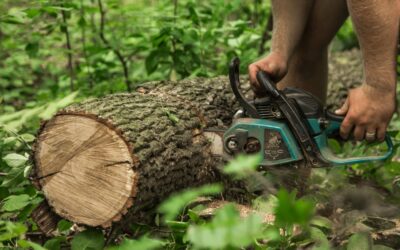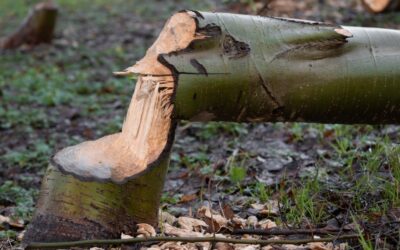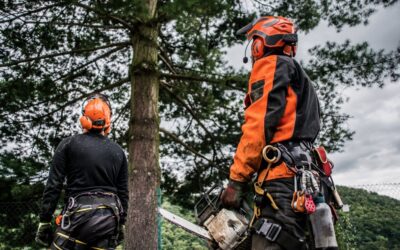After the dust settles and the tree service team has left your property, you might find yourself looking at your landscape wondering, “What’s next?” Whether it’s a freshly pruned silhouette against the sky, a stump where a mighty oak once stood, or the neatly trimmed hedges along your walkway, post-service care is crucial for the health and beauty of your garden or landscape.
In this post, we will shed light on the essential steps you as the homeowner or property manager should take after your trees have received professional attention. These aftercare tips aim to ensure your trees and landscape not only recover but thrive following arborist services.
Contents
The Importance of Post-Service Tree Care
When we think about tree services like pruning, removal, or even hedge trimming, it’s easy to overlook the stress these actions can impose on your trees. It’s not just about removing unwanted branches or making our gardens look neat; these processes can have a profound impact on a tree’s health and vitality.
Pruning, for instance, involves cutting away parts of the tree, which can leave it vulnerable to infections and pests. Similarly, tree removal disrupts the landscape and can affect the soil and surrounding vegetation. Even arborist services that seem less invasive, such as hedge trimming, require precise cuts to prevent damage to the plant.
As such, post-service care is not just about recovery; it’s about setting the foundation for long-term health and vitality. Proper aftercare ensures that the benefits of tree services extend far beyond the immediate aesthetic improvements, contributing to a robust and thriving garden ecosystem.
Immediate Aftercare: First 24 Hours
After any professional tree service, it’s crucial to take immediate steps to ensure the health and recovery of your trees and surrounding landscape. These initial measures set the stage for successful healing and growth, helping to mitigate stress and prevent potential issues.
Immediate inspection
Once the tree service team has completed their work, conduct a thorough inspection of the area. Look for any debris, such as branches, leaves, or wood chips, that may have been left behind. While some organic material can be beneficial if properly composted into mulch, large pieces can smother grass or garden beds, hindering growth.
Water and protect
If the service involves pruning or trimming, gently water the affected areas to help ease the trees back into their growth cycle. Avoid heavy watering which can overwhelm the fresh cuts. As a general rule, aim to keep the soil around the tree moist but not waterlogged. A slow, deep watering method is often best, as it allows moisture to penetrate deeply into the soil, reaching the tree’s roots more effectively.
Clean the surrounding area
A clean environment is crucial for preventing the onset of diseases and deterring pests. Tree services can expose trees to new vulnerabilities, and leftover debris can harbour harmful pathogens or create inviting homes for pests. By promptly clearing away any unnecessary waste, you reduce these risks, creating a healthier environment for your trees and plants to thrive.
Protect fresh cuts or exposed areas
Fresh cuts from pruning or tree removal services can be vulnerable to infections and pest invasions. Trees have natural mechanisms to seal wounds, so focus on maintaining overall tree health through proper watering, mulching, and soil care, which will strengthen the tree’s natural defences.
Long-term Care Strategies
The journey of nurturing trees back to full health doesn’t end with immediate aftercare. Long-term tree care strategies are necessary for a thriving landscape. From nutrient management to regular watering schedules, pruning aftercare, and dealing with leftover stumps and roots, each aspect plays a significant role in the holistic well-being of your trees.
Nurturing the Soil
- The Foundation of Health: The soil is the lifeblood of your garden. After a tree removal or heavy pruning, the soil needs rejuvenation. Consider adding organic compost or mulching to replenish lost nutrients.
- pH Testing and Adjustment: Trees have preferred pH levels. After extensive work, testing, and adjusting your soil’s pH can help remaining or new plantings to prosper.
Watering Wisdom
- Consistency is Key: Develop a watering schedule that aligns with the needs of your trees and plants, especially during their recovery phase. Over or under-watering can both be detrimental.
- Mulching Matters: A layer of mulch around the base of your trees can help retain moisture, regulate soil temperature, and reduce weed competition. However, avoid volcano mulching, where mulch is piled high against the trunk, as this can cause rot.
- Choose the right type of mulch: Mulching is a critical aspect of nutrient management and soil health. A proper layer of mulch helps conserve soil moisture, regulates temperature, and reduces weed competition. Organic mulches, such as wood chips or bark, are generally preferred. Ensure the mulch is not piled against the tree trunk, which can lead to rot, and maintain an appropriate depth of 2-4 inches.
Pruning and Tree Trimming Services Aftercare
- Wound Care: While trees naturally heal over pruning wounds, avoid applying sealants, which can trap moisture and encourage decay.
- Monitor signs for disease or pest activity: Regularly inspect pruned trees for any unusual signs, such as discoloured leaves, oozing sap, or visible pests. Early detection and intervention can prevent minor issues from becoming serious problems.
Stump and Root Care
After a tree removal service, including professional tree stump removal, it’s crucial to decide on the next steps for the area.
- Fill the void: Once a stump is removed, fill the hole with quality topsoil to prevent sinking, create a level surface for new plantings and help rehabilitate the area.
- Root decay: Understand that the decaying process of leftover roots may take years, affecting soil nutrients. Consult with a tree surgeon in Leicester, a tree surgeon in Market Harborough, or your local area for advice on managing this transition.
Leveraging Professional Arborist Services for Continued Health
Establishing a relationship with certified arborists for ongoing health maintenance of your trees is a wise step forward. Arborists, with their extensive training and certification, are equipped to provide specialised care that ensures the longevity and vitality of your trees.
Scheduled Maintenance
Regular check-ins from professionals like those offering tree pruning services can help maintain the shape, health, and vigour of your trees.
Expert Advice
Arborists can provide specific recommendations for your unique landscape, including when to engage in hedge tree trimming services or additional tree removal if necessary.
Preventive health care
Regular maintenance services provided by tree surgeons in Leicester, tree surgeons in Market Harborough or your local area can help address minor issues and prevent them from developing into major problems that require more drastic measures, ensuring the longevity and sustainability of your landscape’s arboreal assets.
Nurturing Your Trees Towards a Flourishing Future with Woods Tree Care
Caring for your trees post-service isn’t just about maintenance; it’s about creating a thriving, resilient landscape that brings joy and beauty for years to come. From immediate aftercare in the first 24 hours to long-term strategies, every step you take makes a difference.
Remember, you’re not alone in this journey. Professional arborist services, from tree pruning services to tree stump removal and hedge tree trimming services, are invaluable resources in ensuring the health and beauty of your landscape. Whether you need a tree surgeon in Leicester or a tree surgeon in Market Harborough, professionals like Woods Tree Care are here to help.
Take the next step in your tree care journey.
Reach out to us today at 0116 239 5185 and ensure your trees receive the expert care they deserve.



